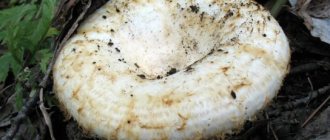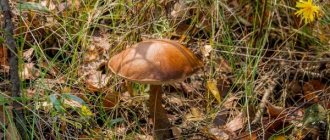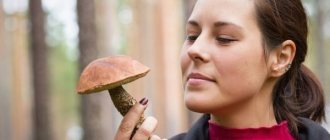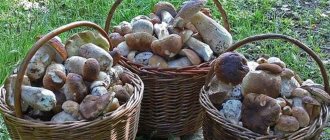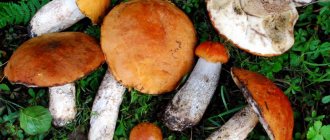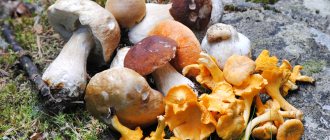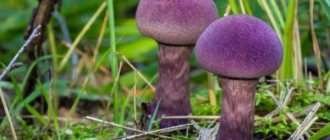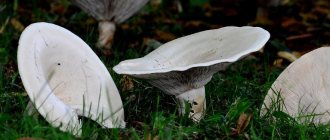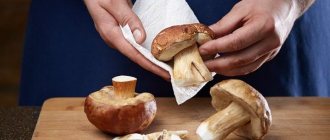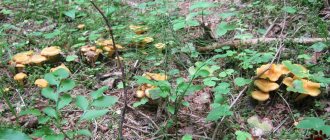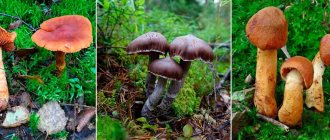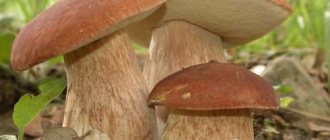Mushroom with a white cap and a thick white stalk. Types of edible agaric mushrooms
This subspecies combines thousands of varieties.
There are many similar, false, and poisonous ones, so in order to always choose edible mushrooms, you need to study photos, characteristics and features of representatives of the species. The most famous species of this group can be considered:
- Milk mushroom, which is common in the northern regions of Russia, the Urals and the Volga region. Loves moist, shaded places and grows close to the ground. The mushroom has a wide white cap, which is connected to a very thick stalk. The flesh of the fruiting body is elastic, but very brittle; milky juice is released at the break, which turns yellow in the open air. It has a pleasant specific aroma.
- The common champignon has a forest counterpart, which grows throughout Europe in forests, semi-deserts, and in the Russian Federation it is found in temperate zones. Fruits from June to October. This is a mushroom with a brown spherical cap and a long thin stalk of white or gray color. The pulp is dense, white, darkens when exposed to high temperatures. It has a pleasant powdery smell.
- Russulas are common in Europe, Asia, Russia, America, and are found even in Africa. Often found in deciduous and coniferous forests and swamp areas. They grow from June to October. The color of the hemispherical cap is brown, reddish, brown, it is attached to a thick white stem. The pulp is white in color and the structure is very soft and crunchy. Russulas have a pleasant forest smell and delicate taste.
Advice from experienced mushroom pickers
You may be interested in: How do edible talkers differ from false mushrooms? How many days after rain do mushrooms grow? Bitter mushroom: photo and detailed description
It is extremely difficult to collect truly edible mushrooms on your own if you do not know their features and characteristics. Therefore, before going to the forest, mushroom pickers recommend studying special literature. Particular attention should be paid to a detailed examination of the structure of the fruit.
Do not touch the mushroom if it seems “suspicious”. It is also not recommended to collect overripe fruits. Harvesting needs to be done in areas remote from roads. You cannot take home fruits that grow in environmentally polluted areas, or in close proximity to sedimentation tanks, places with large accumulations of garbage, etc.
Baskets woven from wicker are well suited for mushrooms. In this case, it is recommended to place the fruits in them with their caps down. If the mushrooms are tightly embedded in grass, foliage, moss or other litter, then such obstacles should only be removed with a stick.
Simple tips will help you avoid the dangers posed by various types of mushrooms. Equally important is compliance with the rules for their preparation and consumption. And, of course, we must not forget that such products have contraindications for use. If they are neglected, the harm to health will be quite serious.
Mushroom with a white cap and white stem. Lamellar delicious mushrooms
Despite the fragile flesh, which often breaks during cooking, lamellar mushrooms are very good, especially when fried or pickled. But, unfortunately, they are rarely used for soup for the same reason, except for honey mushrooms and some other types - they are more elastic and hold their shape better than others.
Among the edible agaric mushrooms that deserve attention:
- Lemon oyster mushroom. One of those mushrooms with which you can do anything, including boiling, it’s a pity that it grows only in the Far East. The caps are small, maximum 10 cm, of a beautiful lemon color, the plates smoothly turn into a rather long stalk, like an oyster mushroom (about 9 cm), which initially grows in the center, but shifts with age. The pulp is white and tender, smells like flour, but in old mushrooms it becomes coarse.
- Wet pink. Despite the nasty mucus that completely covers the light brown cap with rare dark spots, the mushroom is very tasty when fried and pickled. The only thing that needs to be taken into account is that the thick plates under the cap should still remain white, because in old mushrooms they turn black and the mushroom loses its presentation, especially when boiled.
- Gossamer violet. One of those mushrooms that is difficult to confuse - its purple color immediately attracts attention, but should not scare away, since the mushroom is quite edible. The slightly convex cap below has darker plates and stands on a rather high stem. The pulp is the same color and smells like leather.
- Russula blue. It is characterized by a fleshier cap with thick white plates, while the cap itself is colored a beautiful blue-lilac color with a darker center. The white stalk in the center is slightly thicker. The pulp is light and pleasant to the taste.
- Forest champignon. One of the most delicious mushrooms with unusually aromatic and sweet light flesh, which turns slightly brown when broken. It differs from its “pale-faced brothers” in having a brown cap covered with scales.
Conditions of appearance
Mold spores are very small, invisible to the naked eye. They are found everywhere around us - in the air, soil, on plants and objects, and are easily transported with air masses.
Where mold lives depends on the type of fungus. One prefers plants, another prefers wood, and the third prefers cereals. But the reasons for the appearance of mold are the same for all fungi. Once the spores find themselves in favorable conditions, they begin to actively reproduce.
Mold is formed due to factors such as:
- presence of a nutrient medium;
- high humidity;
- lack of air circulation;
- comfortable temperature.
As for the last point, for most fungi a temperature of +18…22⁰С is comfortable. However, some varieties in a moist nutrient medium can reproduce even at temperatures slightly above 0⁰C.
Mushroom with a white cap. White mushroom: description, types, photos
The porcini mushroom is the most delicious, nutritious and valuable representative among the entire kingdom of mushrooms. Even inexperienced mushroom pickers easily recognize the porcini mushroom and fill their baskets with it.
Let's take a closer look at: a description of the porcini mushroom, when to collect porcini mushrooms, where porcini mushrooms grow, types of porcini mushrooms and beneficial properties, how to grow porcini mushrooms in the country.
Why is this mushroom called white? The porcini mushroom got its name back in ancient times. Because of its marbled white flesh, even after drying and heat treatment, the flesh remains white, in contrast to darkening mushrooms. Some also call it boletus, capercaillie, mullein.
White mushroom description
Porcini mushroom has a delicate aroma and spicy taste. The cap of a mature mushroom grows on average 7-30 cm in diameter. But in some latitudes, with heavy rainfall, you can find a porcini mushroom with a cap diameter of 50 cm.
The color of the cap is from light brown to dark brown - it all depends on the trees under which the mushrooms grow.
A young mushroom has a convex cap; as the mushroom ages, the cap becomes flat.
In dry and windy weather, the mushroom cap becomes covered with small but deep cracks, damaging the mushroom. In rainy weather, a film of mucus is visible on the top of the cap.
A ripe mushroom has juicy, dense, fleshy flesh of an attractive white color.
The stem of the porcini mushroom reaches a height of 12 cm, the diameter of the stem is 7 cm. The shape of the stem is barrel-shaped or club-shaped, which distinguishes the porcini mushroom from other mushrooms. The color of the stem varies from white to deep brown.
Where do porcini mushrooms grow?
The porcini mushroom grows on all continents, with the exception of cold Antarctica and arid Australia.
Most of all, the white mushroom is found in coniferous-deciduous forests with pine, oak, birch, and spruce. They prefer to grow under trees over 50 years old, they love lichens and places covered with moss.
The weather for mushroom growth should be warm and rainy - June - August temperature 15-18 degrees, September - 8-10 degrees. Prefers warm, foggy nights - this is the time of harvest.
The porcini mushroom does not like waterlogged places - peat bogs and swamps.
The growth of porcini mushrooms begins in June and continues until September; mass collection occurs in August. In the southern regions it can grow until October.
Mushrooms grow in columns-rings and families, so if you encounter only one mushroom in the forest, you will certainly find more.
Types of porcini mushrooms - photos and names
Depending on their habitat, porcini mushrooms come in different types.
Porcini oak mushroom - the cap is brown, not brown with a grayish tint. The pulp is loose, not as dense as that of birch forms. Found in oak forests from June to October.
The white pine mushroom is a large cap with a dark color. The pulp under the skin is brown in color. Can be found in pine forests. The mushroom stem is thick and short.
Birch porcini mushroom - the cap is light, almost white with a diameter of 5-15 cm. It grows exclusively under birch trees in birch forests and groves. Can be found from June to October alone and in groups.
Spruce porcini mushroom is probably the most common type of porcini mushroom. The leg is elongated and has a thickening at the bottom. The hat is reddish-chestnut in color. Spruce mushroom can be found in spruce and fir forests.
False white mushroom (gall mushroom) - the main difference from the white mushroom is that when cut, the flesh of the false mushroom darkens and becomes pinkish-brown. When cut, the porcini mushroom remains with white flesh.
The gall mushroom has a pronounced mesh on its stalk, which the edible white mushroom does not have.
The tubular layer of the gall fungus is pink; in a real porcini mushroom, this layer is white or yellowish.
A gall mushroom with bitter pulp that does not change even after boiling and frying, unlike the edible one.
Beneficial properties of porcini mushrooms
Porcini mushrooms contain a large amount of minerals, which is why they are the healthiest and most popular mushroom.
The pulp of the porcini mushroom contains an optimal amount of selenium, which can cure cancer at an early stage.
The pulp also contains calcium, iron and phytohormones.
The white mushroom contains riboflavin, which helps normalize the thyroid gland and improves hair and nail growth.
How can a person get mucormycosis?
This requires a combination of several factors. The most important of them is the state of the human immune system. With a normal immune status, with an intact immune system, disease is absolutely impossible, because our immune system instantly identifies and neutralizes fungal spores. They are not dangerous to us.
Immune suppression is possible due to certain diseases: HIV, AIDS. Or when we receive drugs that suppress the immune system: such drugs include, for example, dexamethasone and other steroids that can be used long-term to treat coronavirus infection. When dexamethasone is prescribed by doctors left and right without any indication, in large doses and for a long time, the immune system is suppressed, ceases to recognize those same fungi and stops fighting them.
But depression of the immune system alone is actually not enough; certain factors are also needed: conditions in which microcirculation in the skin and mucous membranes is impaired. One of the most dangerous conditions is diabetes mellitus. Especially type 2 diabetes, which is undiagnosed and uncontrolled. When “coronavirus + dexamethasone + type 2 diabetes mellitus,” then the development of the disease is possible.
shutterstock.com
White mushroom with a white cap. Bile mushroom
Most often, boletus mushrooms are confused with gall fungus.
Gall mushroom - Tylopilus felleus
False white mushroom: gall mushroom
Bitter mushrooms from the genus Tilopil and the Boletaceae family, popularly called bitter mushroom, bitter mushroom or hare mushroom. Externally, bitterling resembles a porcini mushroom.
The diameter of its cap can reach 15 cm, but on average it is about 4-10 cm. The cap, which initially has the shape of a hemisphere, subsequently expands and becomes flatter and prostrate. The color of the cap varies from yellow-brown to dark brown; there are specimens with a gray-ocher cap. In humid weather it becomes sticky.
The strong and heavy stalk of the gall mushroom with whitish flesh grows up to 1.5-3 cm thick and 3-12.5 cm tall. It is distinguished by a swollen fibrous base, a club or cylinder shape, and varying colors from cream to brownish-yellow. A clearly drawn dark or creamy yellow mesh is noticeable in the upper part.
The pulp, which turns red when cut, is not damaged by worms, has a weak odor and a bitter taste. A tubular layer, consisting of white tubes gradually grading to pink and pinkish-gray tones, is attached to the stem of the mushroom.
What does a false white mushroom look like?
The spores of the false porcini mushroom are ellipsoidal, colorless (occasionally pinkish-gray) and smooth, the spore powder is pink-brown or pale pink.
Even after boiling or frying, the taste of the mushroom does not change for the better, but, on the contrary, becomes even more bitter, which is why bitter mushrooms are classified as inedible mushrooms.
False white mushrooms are usually found in forests with coniferous trees, on light loamy or acidic fertile soils, and sandstones. Occasionally, bitterweed grows on half-rotten stumps or tree bases. It is found everywhere, on any continent; in Russia it usually grows in the middle zone.
False porcini mushrooms, bearing fruit from early summer to September-October, form small groups or grow individually.
Young bitter mushrooms are similar not only to boletus mushrooms, but also to boletus mushrooms.
How to avoid getting mucormycosis?
1. You should not eat hormones when they are not prescribed to you. If you have been prescribed them, then both you and the doctors need to stop in time. 2. If there are factors that can lead to mucormycosis, then they must be eliminated: control sugar, do not take iron supplements. If you have an immunodeficiency and a combination of the above factors, you need to be careful. 3. Diabetics and people recovering from coronavirus (while taking hormones) should not do garden work or dig for worms. Contact with soil, especially with compost pits, is dangerous. 4. The respiratory tract should be protected. If it is not possible to avoid contact with these spores, wear a respirator. 5. Avoid skin contact with soil.
shutterstock.com
A lamellar mushroom with a brown cap and a white stalk. Review of conditionally edible mushrooms
Conditionally edible mushrooms are those that are allowed to be eaten only after processing. It can be salting, boiling, frying, drying, blanching or soaking. This is due to the fact that conditionally edible mushrooms contain mildly toxic substances or bitter milky juice.
Tubular
The genus of tubular mushrooms has a wide, fleshy cap. The spore-bearing layer looks like a porous sponge with holes in the form of miniature tubes.
Wolf boletus
The cap is convex, at first it is rough, later it becomes smooth. Its width is 15-20 cm. The color directly depends on the age of the boletus:
- only the sprouted caps have a pale brown or light gray color, the pores are small and yellow;
- “adults” have caps of red, orange or pink color, the pores are large and red.
The flesh is fleshy, waxy or yellow in color; when cut or damaged, it turns blue.
The legs are yellow with brown-red spots, fleshy, with a diameter of 1.5 to 7 cm, and a height of 4 to 9 cm.
Wolf's boletus loves limestone, warm climates, oak and beech forests. Collection time is November-December.
Poddubovik
The mushroom cap can be from 2 to 25 cm wide. At first it has the shape of a hemisphere, but the older the mushroom, the more it bends, and its edges are wrapped. The color is light yellow or brown, and if damaged, the mushroom turns blue. The pulp is dense and dry.
The leg is elongated, but at the bottom it thickens and darkens to brown, in the middle part it is yellow, and turns red at the cap. Has a red mesh. The pulp is loose, sometimes with voids. Leg length – from 2 to 10 cm.
This mushroom prefers oak forests, but can grow in other deciduous forests. It is usually found on the edges or clearings. It can be collected from June to September, and in warm autumn until November.
Common dubovik
The cap of the common oak tree is fleshy, convex, and rough. It can reach 18-19 cm in width. Color yellow-brown or gray-brown. The pulp is dense, yellow in color, but when cut it turns blue-green and later turns black.
The pores of the cap are small, in young oaks the color is ocher, in “teenagers” they are orange or red, and in mature and large ones they are dark gray-green.
The leg seems to be covered with a brown mesh, its color is gradient - yellow at the cap, dirty yellow in the center, and olive near the base.
Common oakberry bears fruit in both deciduous and mixed forests; most likely this mushroom can be found at the roots of oaks and lindens. Collection period – August-September.
Speckled oakweed
The hat of this type is similar to a hemisphere and has a brown or dark brown color. The flesh is yellow, changing color to blue-green when cut. When it rains, the cap becomes covered with mucus, and if you press it, it turns black.
The pores of young mushrooms are yellow, while those of “adults” are orange and red. In places of damage they turn blue. The spores are dirty olive in color.
The leg is dense and wide - up to 4 cm in longitudinal section, height 4-16 cm. When the mushroom appears, it is round, then takes a cylindrical shape. Its color is yellow-orange with numerous bright red splashes.
Speckled Oak loves coniferous forests, as well as places where oaks and beeches grow. Collection takes place from May to October.
Ruby oiler
The cap of the ruby oiler can be painted brick, dirty yellow or red. Width - from 4 to 8 cm. While the mushroom is young, its cap is convex, as it matures it bends, and the edges rise to the top. The flesh is yellow, turning pink at the tubular edge.
The leg is thickened at the base. Near the cap it is purple, closer to the soil it becomes yellow, and the color of its flesh also changes.
The ruby butterfly can grow on half-decomposed oak wood, but prefers the ground. It usually grows in oak forests, but is also found in mixed deciduous or coniferous-deciduous forests. The fruiting period occurs in August and September.
Oil can Kozlyak
The cap is smooth, has a diameter of 7-12 cm. It has a reddish color, which can darken to brown. With age, it sags, forming something like a plate. The pulp is rubber-like in density and light yellow in color, but may acquire a red tint when cut.
The leg is light orange, thin (no more than 2 cm wide), often curved, cylindrical in shape, and thickens near the soil. Height varies from 6 to 10 cm.
Collection time is from July to September. The goat loves pine forests with moist soil.
Oiler Siberian
The cap is slimy, lumpy, light yellow with brown or red convex spots. With age, its edges bend upward. In cross section it is 4-10 cm. The pulp, tubular layer and pores are yellow, and when damaged they acquire a red tint. A mature representative has brown spores. The tubular layer of the young mushroom is covered with a light fleecy film, which, as it matures, breaks off and can hang down, leaving a leg ring.
Application
Jaundice is often used in cooking. When cooked, it acquires a pleasant smell of fried chicken. It is also dried and pickled.
The species is widely used in medicine. Tinctures are prepared from it, which increase immunity and also treat the stomach and heart.
In cooking
This mushroom is edible and has good taste. Used when preparing first and second courses. It is often consumed fried. To prepare this dish you need:
- mushrooms – 350 g;
- sour cream – 1 glass;
- onion – 100 g;
- butter;
- salt, spices.
The onion is finely chopped and fried in oil, then chopped mushrooms, spices and salt are added. Then add sour cream and simmer for 5-7 minutes. This dish is used as a sauce.
The yellow mushroom is also often dried for the winter. It is washed, dried, cut into large pieces and strung on a thread. Avoiding exposure to direct sunlight, dry in a well-ventilated room. There should be a distance of about 1 cm between the pieces. With this drying method, it is best to cover the mushrooms with gauze to prevent insects from “visiting” the workpiece.
At home, the orange mushroom is dried in the oven. It is cleaned, cut into slices and carefully placed on a wire rack or tray lined with cooking parchment. It is important that the mushrooms lie loosely. The temperature should initially be no higher than 40-45 °C. When the plates wither and stop sticking to the parchment and dry, the temperature is increased to 75-80 ° C and left there until completely dry. Also, do not close the oven door tightly during drying. This is necessary for good ventilation.
In medicine
Regular consumption of this product strengthens the immune system.
It is especially useful to eat it during the rehabilitation period. Jaundice extract is used to treat skin diseases. If you regularly wipe the problem areas with the solution, the rash will quickly go away. Powder from dried mushrooms is used to treat wounds. They are sprinkled 3-4 times a day until they are completely healed.
To improve general health, prepare a tincture:
- dried mushrooms are ground;
- add 50 ml of alcohol or vodka and honey;
- leave for 3 days in the refrigerator.
This medicine is taken 2 times a day 30 minutes before meals. They also treat varicose veins. Fresh mushrooms are poured with 1 liter of alcohol and left for 1.5-2 weeks. Diseased areas are lubricated 4-5 times a day. The course of treatment lasts 2 months.
What is the name of a mushroom with a brown cap and a white stem? With brown
Mushrooms with a brown cap are usually highly rated by mushroom pickers. They have dense, tasty pulp with a bright, rich mushroom aroma. Among them, edible ones include:
- The porcini mushroom is one of the remarkable representatives of edible mushrooms with a light brown convex spherical cap. The pulp is dense and does not change color when cut. The mushroom grows in clean forest sandy clearings almost all summer. It is considered a delicacy product.
- Boletus is a large tubular mushroom with a fleshy cap of a rich brown color and a massive white stem. Grows mainly in deciduous forests. Has a high level of nutritional value.
Boletus
- Milk mushroom is a large mushroom with moisture-preserving properties that grows mainly in coniferous forests with sandy soil. The diameter of the cap is 20 cm, and the thick and dense stem is almost equal to its width. Due to its taste, it is used for preparing a variety of sauces.
Gruzd
- Butterflies are bright representatives of coniferous forests with a convex tubular cap covered with a small layer of mucus, which gives the mushroom a beautiful shine. The thin stem bends under the weight of the cap as the plant grows. Used in any form: pickled, fried, in sauces.
Butter
- Honey mushrooms grow in groups on stumps or near deciduous trees. Each mushroom is small in size. Young honey mushrooms have light brown caps, somewhat convex in shape, while older ones are flat.
Honey mushrooms
- Truffles are a delicacy with a dark brown cap and grow underground, making them very difficult to collect. They are mainly found on the rhizomes of oak or pine trees in old forests.
- Collibia oilum has a wide convex light brown cap with a depressed middle. At high humidity, the cap changes color to dark brown with a red tint. The leg is long and thin, hollow inside. The pulp is milky in color and has a good taste.
- Common milkweed grows in oak forests. The cap is light brown and flat-shaped, with fleshy flesh that darkens when cut, forming a light-colored juice. The sweetish taste is suitable for preparing many dishes, including sauces, salting, and pickling. Fresh fruits have an unpleasant odor, which disappears after heat treatment.
Milkman
- The brown oak tree is common in mixed forests and is distinguished by a large brown cap and a dense, white and yellowish stem. When damaged, the pulp changes color to blue; after boiling, this shade disappears and the mushroom acquires its normal color. The taste is not inferior to porcini mushroom, and is not susceptible to worms.
Life hacks for correct definition
The following are tips to follow when searching for edible mushrooms:
- It is recommended to go on a hike early in the morning. The dew on the mushroom caps is still there at this time. Thanks to its shine, prey can be easily spotted.
- It is advisable to find out in advance what the forest is rich in: what trees and edible mushrooms (russula and boletus grow in the birch forest, saffron milk caps grow in the pine forest).
- When identifying, look for toadstools, which are often white and green.
- Lamellar mushrooms have false doubles, so it is better for beginners to take a closer look at the tubular species (boletus, boletus, boletus, boletus).
- Do not pick the fruit completely, otherwise next year you will not give the whole family a chance to grow. According to the rules, the distance from the ground to the cut should be 0.5 - 1 cm.
Important! The presence of wormholes in large specimens indicates the edibility of the fruiting body.
